|
|

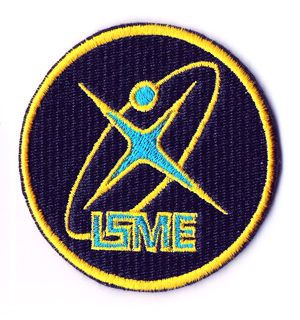
The Shenzhou-5 mission patch (78 x 92 mm) and the Istitute of Space Medico-Engineering (73 mm dia).
| Crew & Mission |
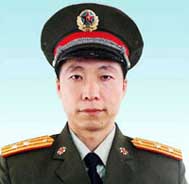
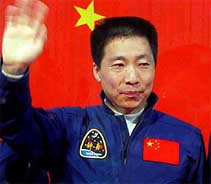
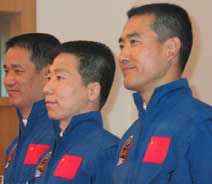
Chinese astronaut, Yang Liwei in militair uniform and waving to journalists during a news conference at Jiuquan Satellite Launch Center in northwest China's Gansu Province, Tuesday, Oct. 14, 2003. The three final astronauts from China, Nie Haisheng, left, Yang Liwei, center, and Zhai Zhigang October 14, 2003.
The astronaut Yang Liwei, from Liaoning Province and aged 38, is one of the 14 member Astronaut Team of China and a lieutenant colonel of the People's Liberation Army (PLA). As a Chinese astronaut of the first generation, he was an excellent fighter pilot of PLA air force with the flight experience of 1350 hours. In 1998, he was selected as an astronaut. After five years' hard training and study, he stood out excellent in all of his studies. Before the launch, the command center of the manned space flight made the decision that Yang was to carry out the first manned flight. According to the plan, Yang would take the spacecraft to fly around the earth for 14 times and then to land in the middle of the Inner Mongolia.
 China's first manned spacecraft, the Shenzhou-5, blasted off from the Jiuquan Satellite Launch Center in the northwestern province of Gansu at 9 a.m. Wednesday October 15, 2003. The spacecraft, Shenzhou V, is mainly developed by Chinese Academy of Space Technology (CAST) and Shanghai Academy of Space Navigation, which are subordinated to China Aerospace Science & Technology Corporation (CASC). The spacecraft consists of several such modules as propelling, returning and orbit and an attachment module as well. The spacecraft can carry three astronauts.
China's first manned spacecraft, the Shenzhou-5, blasted off from the Jiuquan Satellite Launch Center in the northwestern province of Gansu at 9 a.m. Wednesday October 15, 2003. The spacecraft, Shenzhou V, is mainly developed by Chinese Academy of Space Technology (CAST) and Shanghai Academy of Space Navigation, which are subordinated to China Aerospace Science & Technology Corporation (CASC). The spacecraft consists of several such modules as propelling, returning and orbit and an attachment module as well. The spacecraft can carry three astronauts.
The "Long March CZ-2F" carrier rocket, which carried "Shenzhou V" into orbit, was developed mainly by China Academy of Launch Vehicle Technology (CALT) which is a subsidiary to CASC. This rocket is a kind of clustered carrier with enormous propelling power developed for the project of China's manned spacecraft, which has succeeded in five launches in succession since Shenzhou I was sent into space in 1999.
Touchdown of the Shenzhou-5 capsule came at 6:23 a.m. local time October 16, 2003. Chinese media reported that the landing spot was just 4.8 kilometers from the targeted touchdown site in Inner Mongolia. Yang Liwei was carried away from the spacecraft in a seat and looked a bit wobbly and dazed on state television coverage of the event. Official reports from Xinhua say Yang "was confirmed to remain in good health" after his 21-hours in orbit.
The first Chinese manned space mission lasted approximately 21 hours, 23 minutes from liftoff to touchdown. The historic flight completed 14 orbits of Earth and traveled about 600,000 kilometers.
The Shenzhou 5 patch depicts the Chinese characters spelling out 'Shen Zhou', meaning 'devine vessel'. A red swirl ends in a stylized figure of Chang'e, the Chinese goddess of the moon in a dress trailing ribbons; these two elements form the numeral '5'.
| The real thing |
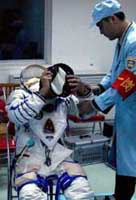
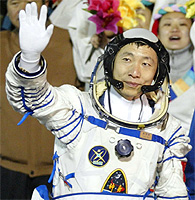
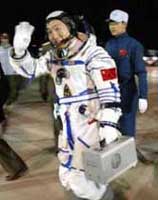
Left: China's first astronaut Yang Liwei puts on a helmet during training the day before his flight into space, note the patches on the helpers suit. Middle and Right: Yang Liwei waving before boarding the spacecraft Shenzhou-5 on October 15, 2003.
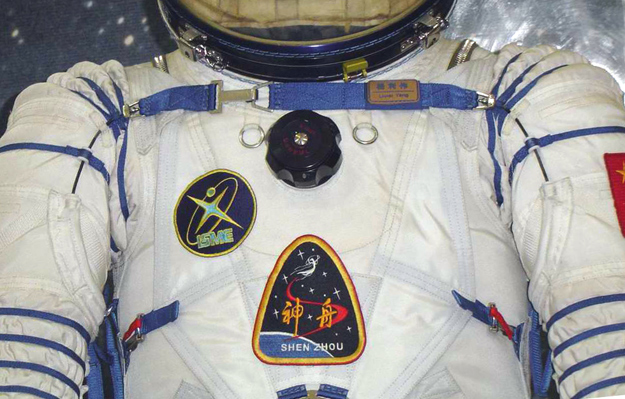
Liwei's flightsuit at an exhibition after the mission.

Close-up of Yang Liwei's nametag as it appeared on his suit.
| In Space |
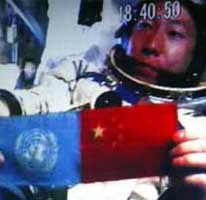
China's first astronaut in outer space Yang Liwei said "hello" to people all over the world from Shenzhou-5 and showed the China's national flag and UN flag from the capsule.
| Non-flight patch |
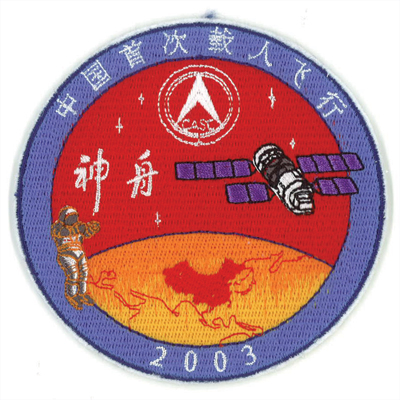
A commemerative patch for Shenzhou 5; no information on pedigree or use.
| Collecting Shenzhou 5 |
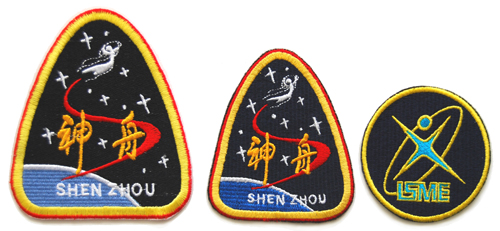
A large version of the SZ5 mission patch, a version of the official patch as above, but without the two stars in the bottom-right corner, and the ISME patch. The 'missing stars' and ISME were available on eBay for some time; the source seems to have been the Hong Kong Aerospace Society.
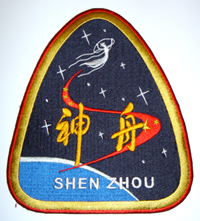
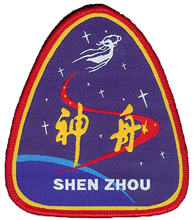
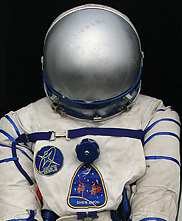
Left: a variation of the SZ5 mission patch that shows five small stars of two sizes within the red swirl. Also, details in the ribbons of the dress of Chang'e are different. Only this online photo is known and more details on this version are lacking. Middle: in February 2009, this Chinese-made variation appeared on eBay, probably based on the reproduction spacesuit shown at the Chinese Space Expo 2008 (right).
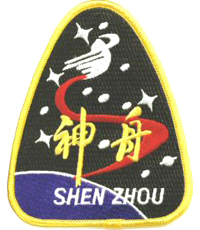
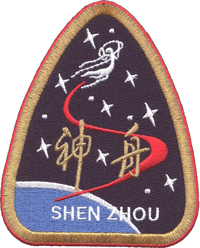
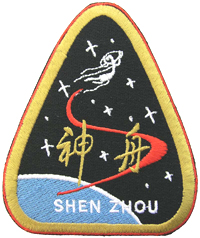
Left: the Randy Hunt version, middle: the Stewart Aviation reproduction, right; an unknown version currently available on eBay.